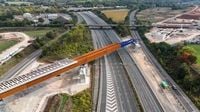There are moments in large-scale engineering when everything simply clicks into place, and for the teams working on the HS2 project near Birmingham Airport, this past weekend was one of them. In a feat that’s been hailed as both innovative and efficient, engineers managed to slide a 230-metre section of the new HS2 East Deck viaduct across the M6 motorway and reopen the busy thoroughfare almost ten hours ahead of schedule. For thousands of motorists and local businesses, that meant a welcome return to normalcy—and for the project, it marked a major milestone in one of the UK’s most ambitious infrastructure undertakings.
The operation began on Friday, September 26, 2025, with both northbound and southbound carriageways of the M6 closed near Junction 4, just a stone’s throw from Birmingham Airport. Over the next two days, a dedicated team—led by the BBV joint venture (Balfour Beatty and VINCI), and supported by the specialist steelwork company Victor Buyck Steel Construction—worked around the clock to move the massive viaduct into place. The motorway was fully reopened by 12:30 pm on Sunday, September 28, a full 9.5 hours ahead of the planned timeline, as reported by New Civil Engineer and Rail UK.
This was the second phase of the viaduct sliding operation, following a successful first phase completed in June 2025. The East Deck viaduct is just one half of a pair of 320-metre twin structures that will ultimately carry HS2’s high-speed trains between London and Birmingham, soaring over one of the country’s busiest motorways. The West Deck, identical in design, is scheduled to be installed in 2026.
What made this weekend’s operation particularly noteworthy was the use of a ‘fully restrained’ sliding technique—a first for the HS2 works in the West Midlands. Developed in collaboration with National Highways, this method allowed engineers to begin launching the viaduct over the M6 slip road while traffic continued to flow beneath during the preparatory stages. Only during the final push was the motorway closed, significantly reducing disruption for road users. “Our focus with any scheme is to minimise the impact on people using or living near our roads while ensuring the work is carried out safely and efficiently,” said Kamaljit Khokhar, National Highways’ Head of Planning and Development for the Midlands. “We are pleased to see how well the work went at the weekend and applaud the innovative techniques HS2 has introduced which have significantly reduced traffic restrictions on this key route by constructing the structure next to the road.”
The logistics behind the slide were as intricate as they were impressive. The 230-metre-long deck—formed from a hollow double-box structure made of weathering steel—was assembled in sections beside the motorway. As each new segment was added, the viaduct’s weight increased, eventually reaching a staggering 4,645 tonnes when fully assembled with both concrete and steel components. To move such a colossal structure, the team used hydraulic winches known as strand jacks, pulling the deck at an average speed of ten metres per hour. To reduce friction, the viaduct was slid across non-stick pads made from the same material you’d find on a household frying pan, and guided by rollers placed atop the supporting piers.
Four pairs of concrete piers, with the tallest standing 9.9 metres high, support the viaducts. A 4.5-metre-high parapet will soon be installed on the side facing Chelmsley Wood to help reduce noise and disturbance for nearby residents—a thoughtful touch for those living close to this major new rail artery. In a move designed to further limit future road closures, the team installed fifty-one precast concrete slabs on top of the steel deck before the slide, allowing for more of the finishing work to be completed without disrupting traffic again.
Coordination was key throughout the operation. The work was carefully planned in consultation with National Highways and other local stakeholders, including Birmingham Business Park, the NEC, and Birmingham Airport. The aim? To minimize disruption not just for motorists, but for the many businesses and travelers who rely on this vital stretch of road. According to Rail UK, “The team worked closely with National Highways to consider the impact of the closure on other planned traffic management in the area, as well as other key local stakeholders.”
For the engineers and project managers involved, the successful completion of the second sliding phase is a point of pride. “This is a major feat of engineering over a vital section of the UK’s transport infrastructure, so to be able to reopen the road early is a fantastic achievement,” said Caroline Warrington, HS2 Ltd’s Head of Delivery. “These viaducts will be pivotal to the HS2 network, carrying high-speed trains over the M6 and creating better journeys for people for many years to come.” Russell Luckhurst, the BBV engineer leading the works, echoed her sentiments: “Thanks to the team’s hard work and engineering expertise using new techniques, we were able to reopen the northbound carriageway on Saturday evening and then the full motorway was open again from Sunday lunchtime—which was great news for road users in the area.”
The HS2 project, now under the stewardship of chief executive Mark Wild, is currently undergoing a comprehensive reset aimed at delivering the railway more efficiently and at a lower cost. This push for innovation and efficiency has already produced several milestones ahead of schedule in 2025. In August, a 1,631-tonne steel bridge was slid into place over Lawley Middleway, four days ahead of plan. Earlier, in June, the Northolt Tunnel—spanning 8.4 miles and requiring four tunnel-boring machines—was completed after moving over four million tonnes of clay and installing more than 14,000 concrete rings. “Completing the excavation of this 8.4-mile-long tunnel on HS2 is a real achievement and one the team should be immensely proud of,” said Alan Morris, HS2 Ltd’s construction delivery director. “We’re building HS2 for the future, to increase capacity on our rail network and improve journeys for millions of rail users.”
Looking ahead, the focus now shifts to the third and final launch of the East Viaduct, planned for later this year, and the subsequent installation of the West Deck in 2026. Local drivers and businesses will be watching closely, as further phases of the M6 south viaduct construction are scheduled for the months ahead. While the project has not been without its critics—particularly those concerned about cost and disruption—recent successes have gone a long way toward reinforcing the benefits of careful planning, technical innovation, and strong collaboration between public and private partners.
For now, as traffic flows once more under the newly positioned viaduct, the HS2 team can take a moment to celebrate a job well done—and to prepare for the next big push in a project that’s reshaping Britain’s transport future, one engineering triumph at a time.




